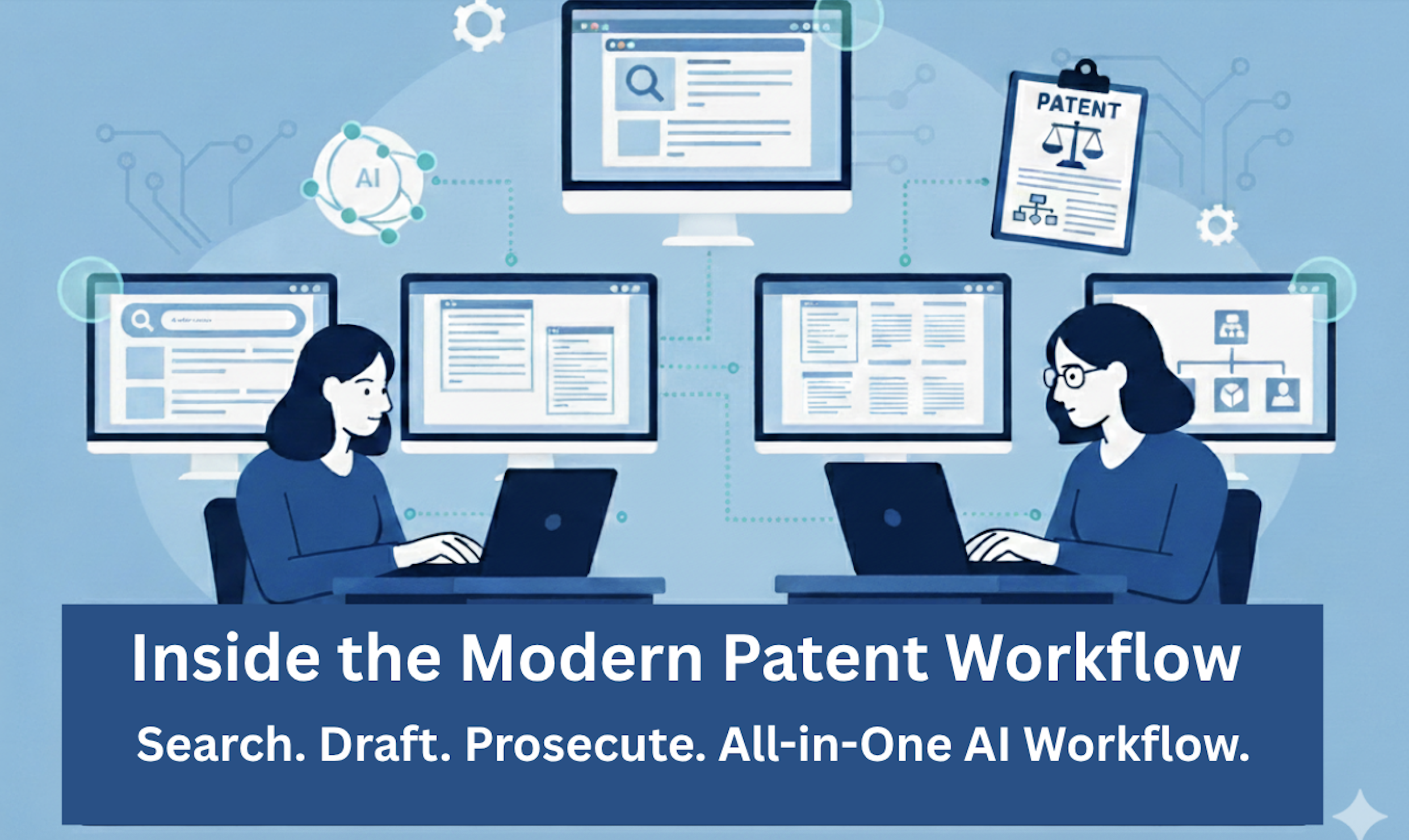
October 13, 2025
The way top IP firms manage patent drafting and prosecution is changing fast.
The old model with one tool for searching, another for drafting, and a maze of spreadsheets for tracking can no longer keep up with today’s pace of innovation.
Leading firms are now adopting AI-driven, integrated workflows that connect everything from prior art search to patent drafting to office action responses — all in one streamlined environment.
This post explores how modern IP teams are using connected AI tools, like IP Author, to transform their practice: working faster, reducing rework, and improving overall patent quality.
The Problem with Traditional Patent Workflows
Before AI, patent drafting and prosecution were entirely manual, a process defined by repetition, rework, and risk.
1. Time and Cost Bottlenecks
Every part of the patent process used to demand hours of manual effort.
- Prior Art Search: Attorneys and analysts spent days combing through endless patent databases using keyword search tools. Even with Boolean filters, finding truly relevant prior art was often slow and incomplete.
- Patent Drafting: Writing claims, preparing specifications, and drawing figures could take weeks. Updates to figures or reference numbers required tedious, error-prone editing across documents.
- Office Actions: Reviewing examiner objections, parsing cited prior art, and drafting structured responses can take days, especially when claim amendments require updating multiple sections across the application.
These inefficiencies not only slowed prosecution but drove costs up dramatically, particularly for firms handling high filing volumes.
2. Accuracy and Risk
Manual systems left too much room for error.
Keyword searches missed relevant patents written in different languages or phrased differently. Drafting mismatches between claims and figures led to needless Office Actions. Even small mistakes — like a misplaced reference number or formatting error — could trigger procedural rejections and costly rework.
The cumulative effect? Weeks of lost time and thousands in avoidable cost.
3. The Fragmented Workflow Problem
For years, patent teams have relied on disconnected systems — databases for prior art, word processors for drafting, and docketing software for prosecution.
That fragmentation causes:
- Repeated data entry and lost context.
- Missed prior art references during drafting.
- Inconsistent claim language across filings.
- Hours wasted syncing figures, claims, and descriptions.
Even with the best attorneys, these inefficiencies slow prosecution and increase the risk of errors — from antecedent basis issues to mismatched figure references.
How AI Is Changing the Way Patents Are Drafted and Prosecuted
Artificial Intelligence is reshaping the way patent professionals search, draft, and prosecute applications. Instead of juggling multiple disconnected tools, modern firms now rely on integrated AI systems that understand context, meaning, and legal nuance — not just keywords.
IP Author sits at the heart of the modern patent workflow — connecting search, drafting, and prosecution into one cohesive environment.
It doesn’t just automate — it collaborates.
AI-Powered Patent Drafting:
Upload your invention disclosure and IP Author generates a first draft that includes claims, background, and detailed descriptions.
The output follows patent office formatting standards and is easily editable — giving attorneys a fast, accurate starting point that reflects the invention’s core novelty.
Integrated Figures and Flowcharts:
IP Author automatically generates and manages flowcharts, block diagrams, and functional visuals. Rename a figure once, and every reference updates instantly across the claims, specification, and legends.
No more manual cross-referencing or inconsistent numbering — IP Author ensures visual and textual alignment from start to finish.
Prior Art–Integrated Drafting:
Because IP Author can integrate prior art insights, it helps attorneys refine claims that clearly differentiate over existing disclosures. The result is stronger, more defensible claims and fewer examiner objections.
AI Assistance for Office Actions:
When an Office Action arrives, IP Author helps draft structured responses faster. It can:
- Summarize examiner objections.
- Extract cited prior art context.
- Suggest claim amendments and argument frameworks.
Attorneys retain full control over strategy, while IP Author accelerates the review and response process — cutting response time from days to hours.
Why Firms Are Making the Shift
Attorneys using IP Author and similar AI-driven tools are seeing quantifiable improvements:
- 50–70% faster drafting cycles.
- Stronger applications, drafted with full awareness of prior art.
- Reduced administrative workload, freeing experts for strategy.
More importantly, these gains don’t come at the cost of control. Attorneys remain in charge of the arguments, scope, and legal positioning — AI simply handles the tedious parts.
The Future of Patent Practice: AI-Driven, Attorney-Led
The firms leading the next decade of IP practice will be those that integrate AI not as a shortcut, but as an extension of human expertise.
With IP Author, attorneys can move effortlessly from prior art search to drafting and prosecution — ensuring every claim is well-informed, every figure stays consistent, and every response is strategically crafted.
The result? Faster filings, fewer rejections, and a stronger competitive edge wherever you file.
The future of patent work is smarter, faster, and powered by AI.
If your team still spends days on manual prior art searches, drafting from scratch, or fixing figure references — it’s time to modernize your workflow.
With IP Author, you can:
- Conduct AI-powered prior art searches that find contextually relevant results beyond keywords.
- Draft complete, compliant applications in hours — not weeks.
- Manage figures and references automatically, with every update synced across your claims and specification.
- Respond to Office Actions quickly and accurately with AI-assisted summaries and suggested amendments.
Experience how IP Author transforms your patent drafting and prosecution process. Book a live demo today and see how AI can make your workflow faster, more precise, and completely connected.